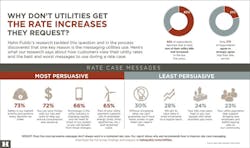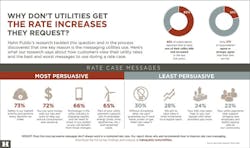By Sapna Mulki
Increasing water rates is almost every public utility’s nightmare. Misconceptions, misinformation and lack of political will often challenge the implementation of full rate increases. One of the most critical elements to getting approval for a full rate increase request is for a utility to implement a communications strategy that uses the right messages.
Rates are not easy to explain - neither to the customer base nor to the regulatory entities with purview over rate approval. Thus, framing messages so that they convey the right information, values and emotions is the key to public communication, and ultimately approval of proposed rates. This article discusses a recent study from Hahn Public Communications that measures the efficacy of the most - and least - persuasive messages that utilities use to justify rate increases.
Raising funds from rate-setting is a necessity for a utility to operate effectively, to implement innovative technologies, to incentivize conservation and to maintain water infrastructure. In 2012, the U.S. Environmental Protection Agency estimated that over $655 billion dollars will need to be invested in water and wastewater infrastructure over the next 20 years.1,2 In fact, in Texas alone, the newly adopted state water plan calls for investments in excess of $62 billion.3
While there are alternative sources of funding from federal and state governments and private financing, it is not enough to fill the wide fiscal gap. Irrespective of the funding structure utilized to implement necessary infrastructure improvements, raising rates is almost always a necessary and viable part of the solution.
Increasing water rates does not have to be a politically or publicly charged issue if the utility communicates effectively with its customers and decision-makers. A strong communication strategy is one that is based on:
- Communication practices that are consistent and constant.
- Values that promote transparency and accuracy.
- Opportunities that allow community engagement.
Messages can be disseminated using various communications tools, such as websites, bills and bill inserts. Increasingly, utilities are also using other outlets that include social media, blogs and online tools such as bill calculators. However, when it comes to rate-setting, the matter is fairly sensitive and so requires a targeted strategy.
The Pacific Institute makes a very similar observation on the contrasting requirements for general communications versus rate-setting outreach: “Although a water service provider will often already have a general communications plan in place, the rate-setting process may require a separate strategy, and elected officials will likely need communications support to underpin their rate decisions.”4
While having the right mix of tools is advantageous, if the messages are not framed in a manner that is relatable/understandable to the target audience, chances for approval of the full increase are less likely. Melanie K. Goetz, author of Communicating Water’s Value, noted in her book that “people react instinctively to how things are framed…Rates are compulsory, and the way those are framed - worded, explained, and presented - can make all the difference in the world in how they are received.”5
Convincing Messages and How to Frame Them
A recent study published by Hahn Public tested the 13 most commonly used messages by utilities and other stakeholders during a rate-setting campaign. The sample size included surveys of 800 utility customers (water, electric and gas) who represented 340 utilities nationwide.6
Messages are defined as fact, feature, character and competence. “Fact- and feature-based messages seek to persuade customers and regulators that proposed increases are fair, justified and worthwhile. Fact-based messages are concrete and speak to verifiable characteristics of a rate increase... Feature-based messages speak to the values that consumers derive from their relationship to the utility, such as security, satisfaction, comfort or convenience.”7
Utilities that are effective in rate-setting communication campaigns tend to use messages that are feature based such as:
- Safety is our highest priority and governs every decision we make.
- You can save money with our tips and tools to help you reduce consumption and conserve.
- Our employees work hard every day to deliver on our promise of reliable water/energy and quality service.
Feature-based messages are more convincing to utility customers because they demonstrate the efficiency and progressiveness in providing better quality service, therefore reinforcing its commitment to customer satisfaction. Character and competence messages are often used by opponents of rate increases. They tend to depict the utility as “greedy and corrupt (character), inefficient and wasteful (competence),” or all of the above.8 Such negative messages are very difficult to neutralize using fact- and feature-based messages but can be dispelled using evidence-based messages.
Fact-based messages explain the intrinsic properties and characteristics attached to a proposed increase. These are measurable, concrete, observable, and relevant in their composition.9 The study by Hahn Public found that the challenge for utilities seeking to improve their performances in rate cases is to strategically identify the character/competency messages opponents use and then develop facts to disclaim the accusations. For example:
Character/competency: “No reason for utility bills to increase - aren’t they making enough money from us already?”
Fact-based message (from Los Angeles Department of Water and Power): “We need to increase water revenue by $230 million over five years to repair infrastructure.”
Accusations against a utility are especially hard to overcome if the entity has not been continually visible in the community and consistently communicating evidence-based messages about programs and projects. For this reason, rate-setting outreach should be conducted throughout the year and not a few months before appealing for an increase from the board or governing body. Such an approach changes behaviors and perceptions through trust building, preconditioning to accept the rate-setting process, and knowing that the utility cares for community welfare and affordability issues.
The Hahn Public research shows how to craft persuasive messages. From the 13 messages tested, it can be deduced that what makes a message persuasive is when details on the following are demonstrated: safety, cost savings, environmental sustainability, adoption of innovative technologies and commitment to high standards of service and customer satisfaction. What makes a message least persuasive is when comparisons are made to other utilities/cities/communities, resources are directed toward non-utility purposes, and water is used to attract new businesses and job growth.
The common theme in whether or not messages work is if they are purposeful, relevant and appeal to the values and emotions of the public. The messages have to reflect the actions but only disseminating the messages and not engaging communities and decision-makers on a one-on-one basis will hinder long-term success. Preconditioning customers to accept and adjust to the change begins with education and awareness that needs to happen on an ongoing basis. Utilities would do well to incorporate character/competency messages into their overall messaging to reduce their susceptibility to spurious accusations. Utilities could partner with third-party messengers (e.g., businesses or individuals) willing to speak out in support of rate increases. In the same vein, blue-ribbon panels can validate the information presented to ratepayers and establish a pattern of fact-based responses to character and competence arguments.
Author’s Note: To access the Hahn Public research paper Rate Case Messaging: The Character/Competency Conundrum, go to www.hahnpublic.com/utilities.
About the Author: Sapna Mulki is Hahn Public’s director for water, consulting with clients on water issues ranging from conservation outreach to rate structure communication. Mulki has over 10 years of experience in water supply, water policy, environmental conservation and social science research. She has experience working in diverse environments and on myriad issues.
References
1. Drinking Water Infrastructure Needs Survey and Assessment Fifth Report to Congress, Environmental Protection Agency, April 2013.
2. Clean Watersheds Needs Survey (CWNS) Report to Congress-2012, Environmental Protection Agency, January 2016.
3. 2017 State Water Plan, Texas Water Development Board, 2016, http://www.twdb.texas.gov/waterplanning/swp/2017/index.asp
4. Water Rates: Communication and Education, The Pacific Institute, 2013, http://pacinst.org/app/uploads/2013/01/water-rates-communication_and_education.pdf,
5. Goetz, Melanie M. Communicating Water’s Value: Talking Points, Tips & Strategies, American Water Works Association, 2014.
6. Groggans, Brooke, Ryan Orendorf and Mike Clark-Madison. Rate Case Messaging: The Character/Competency Conundrum, Hahn Public Communications, 2016, www.hahnpublic.com/utilities.
7. ibid.
8. ibid.
9. Hernandez, Jose Mauro C., Scott A Wright, Filipe Ferminiano Rodrigues. “Attributes Versus Benefits: Thee Role of Construal Levels and Appeal Type on the Persuasiveness of Marketing Messages,” Journal of Advertising, 2014.




